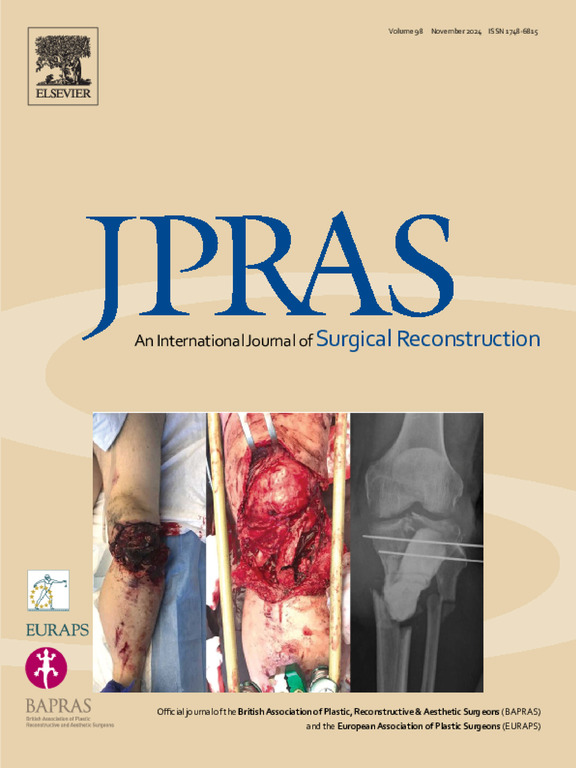同种异体和神经化自体乳房重建后的热与触觉恢复
IF 2.4
3区 医学
Q2 SURGERY
Journal of Plastic Reconstructive and Aesthetic Surgery
Pub Date : 2025-08-21
DOI:10.1016/j.bjps.2025.08.020
引用次数: 0
摘要
背景:乳房切除术后感觉丧失影响长期满意度,但热感觉结果仍未得到充分研究。本研究比较了两期同种异体和神经化自体乳房重建后的触觉和热恢复。方法在这项前瞻性单机构研究中,接受乳房切除术的患者采用两期异体增生或立即神经化DIEP皮瓣重建。在术后4个时间间隔(1-6、6-12、12 - 24和24-48个月),使用压力指定装置评估9个区域的触觉,使用标准热(52°C)和冷(12°C)刺激测试5个区域的热感觉。结果269例患者(440个乳房)接受触觉检查,其中DIEP患者123例(209个乳房),同种异体增生患者146例(231个乳房)。105例患者(174个乳房)接受了热测试。两组术前评分差异无统计学意义(p > 0.05)。DIEP患者在术后每个时间间隔的触觉评分均显著提高:1-6个月(35.7比25.7,p = 0.001)、6-12个月(43.4比33.9,p = 0.015)、12-24个月(46.3比35.2,p = 0.039)和24-48个月(56.5比46.4,p = 0.048)。同种异体移植患者在12-24个月(65.0%比48.6%,p = 0.040)和24-48个月(83.3%比57.1%,p = 0.001)和12-24个月的热感觉(77.3%比54.3%,p = 0.014)明显改善。结论神经化DIEP重建具有较好的触觉恢复效果,而同种异体重建具有较好的热感觉。这种差异可能反映了乳房植入物增强的热传导特性和神经化对热感觉纤维的有限影响。本文章由计算机程序翻译,如有差异,请以英文原文为准。
Thermal versus tactile sensory recovery following alloplastic and neurotized autologous breast reconstruction
Background
Loss of sensation after mastectomy impacts long-term satisfaction, yet thermal sensory outcomes remain understudied. This study compares tactile and thermal recovery following two-stage alloplastic versus neurotized autologous breast reconstruction.
Methods
In this prospective single-institution study, patients underwent mastectomy with either two-stage alloplastic or immediate neurotized DIEP flap reconstruction. Tactile sensation was assessed in nine regions using a pressure-specified device, and thermal sensation was tested in five regions using standardized hot (52 °C) and cold (12 °C) stimuli across four postoperative intervals (1–6, 6–12, 12–24, and 24–48 months).
Results
269 patients (440 breasts) underwent tactile testing, consisting of 123 DIEP patients (209 breasts) and 146 alloplastic patients (231 breasts). A subset of 105 patients (174 breasts) underwent thermal testing. Preoperative scores were similar between groups (p > 0.05). DIEP patients demonstrated significantly higher tactile sensation scores at every postoperative interval: 1–6 (35.7 vs. 25.7, p = 0.001), 6–12 (43.4 vs. 33.9, p = 0.015), 12–24 (46.3 vs. 35.2, p = 0.039), and 24–48 months (56.5 vs. 46.4, p = 0.048). Alloplastic patients showed significantly better cold perception at 12–24 (65.0% vs. 48.6%, p = 0.040) and 24–48 months (83.3% vs. 57.1%, p = 0.001), and heat perception at 12–24 months (77.3% vs. 54.3%, p = 0.014).
Conclusion
Neurotized DIEP reconstruction yielded superior tactile recovery, while alloplastic was associated with better thermal perception. This discrepancy may reflect the enhanced thermal conduction properties of breast implants and the limited influence of neurotization on thermal sensory fibers.
求助全文
通过发布文献求助,成功后即可免费获取论文全文。
去求助
来源期刊
CiteScore
3.10
自引率
11.10%
发文量
578
审稿时长
3.5 months
期刊介绍:
JPRAS An International Journal of Surgical Reconstruction is one of the world''s leading international journals, covering all the reconstructive and aesthetic aspects of plastic surgery.
The journal presents the latest surgical procedures with audit and outcome studies of new and established techniques in plastic surgery including: cleft lip and palate and other heads and neck surgery, hand surgery, lower limb trauma, burns, skin cancer, breast surgery and aesthetic surgery.

 求助内容:
求助内容: 应助结果提醒方式:
应助结果提醒方式:


